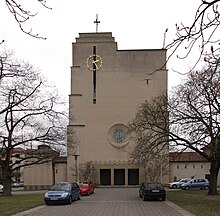Fritz Fuchsenberger
Fritz Fuchsenberger (born October 3, 1876 in Würzburg , † September 14, 1945 in Munich ; full name: Friedrich Fuchsenberger ) was a German architect .
Life
Born in Würzburg, Fuchsenberger studied architecture and, after graduating, joined the state construction service as a construction clerk , initially with the rank of government master builder ( assessor ). Under the direction of the chief building officer Eduard Reuter, he was instrumental in building the new state archive in Bamberg (1902–1905). As an architect, he was responsible for the construction of the former Oberpostdirektion at Wilhelmsplatz in Bamberg (1904–1906). He was later a professor at the Technical University of Munich .
His son Ludwig Fuchsenberger (born June 26, 1906 in Bamberg; † October 18, 1960 in Aschaffenburg) was an architect in Aschaffenburg .
Fritz Fuchsenberger died in Munich in 1945.
Buildings and designs
- 1902–1905: Royal District Archives (today State Archives ) Bamberg
- 1906: Former rectory in Egloffstein ( list of monuments )
- 1907–1908: Church in Burgsinn
- 1908–1909: Church in Adelsdorf
- 1913: Nave of the Catholic parish church St. Aegidius in Gremsdorf
- 1913–1914: Church in Wiesthal in Spessart
- 1919–1920: Pfaffendorf village church
- 1922–1923: St. Sebastian Church in Hundelshausen , Schweinfurt district
- 1926: Expansion of the new Catholic branch church for the Holy Trinity in Gosberg
- 1926–1927: Catholic parish church of St. Karl Borromäus in Nuremberg- Mögeldorf (Fuchsenberger created the design without honoring it)
- 1927–1928: Catholic parish church St. Bonifaz in Erlangen
- 1931: Catholic parish church St. Bartholäus in Priesendorf
- 1932: Church in Schwarzenbach an der Saale
Fuchsenberger designed other churches and church facilities in Helmbrechts , Hohenberg , Ehingen , Hundelshausen ; Niederndorf , Poxdorf , Untertiefengrün and Reichmannsdorf .
literature
- Peter Stuckenberger: Castles of God. Church building under Archbishop Jacobus von Hauck 1912–1943. (= Studies on the history of the Bamberg diocese, Volume 1.) Bamberg 2004, ISBN 3-9808138-2-7 .
Web links
Individual evidence
- ↑ Mention on www.juden-in-bamberg.de
- ↑ Article about the church on Frankenwiki
- ↑ Report on the chapel in Unteriefengrün
| personal data | |
|---|---|
| SURNAME | Fuchsenberger, Fritz |
| ALTERNATIVE NAMES | Fuchsenberger, Friedrich (real name) |
| BRIEF DESCRIPTION | German architect |
| DATE OF BIRTH | October 3, 1876 |
| PLACE OF BIRTH | Wurzburg |
| DATE OF DEATH | September 14, 1945 |
| Place of death | Munich |
